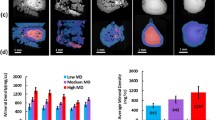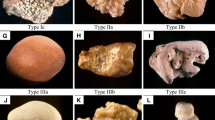Abstract
Apatite and brushite kidney stones share calcium and phosphate as their main inorganic components. We tested the hypothesis that these stone types differ in the amount of proteins present in the stones. Intact stones were intensively analyzed by microcomputed tomography (micro CT) for both morphology (including the volume of voids, i.e., space devoid of X-ray dense material) and mineral type. To extract all proteins present in kidney stones in soluble form we developed a three-step extraction procedure using the ground stone powder. Apatite stones had significantly higher levels of total protein content and void volume compared to brushite stones. The void volume was highly correlated with the total protein contents in all stones (r 2 = 0.61, P < 0.0001), and brushite stones contained significantly fewer void regions and proteins than did apatite stones (3.2 ± 4.5% voids for brushite vs. 10.8 ± 11.2% for apatite, P < 0.005; 4.1 ± 1.6% protein for brushite vs. 6.0 ± 2.4% for apatite, P < 0.03). Morphological observations other than void volume did not correlate with protein content of stones, and neither did the presence or absence of minor mineral components. Our results show that protein content of brushite and apatite stones is higher than that was previously thought, and also suggest that micro CT-visible void regions are related to the presence of protein.





Similar content being viewed by others
References
Stamatelou KK, Francis ME, Jones CA, Nyberg LM, Curhan GC (2003) Time trends in reported prevalence of kidney stones in the United States: 1976–1994. Kidney Int 63:1817–1823
Morton AR, Wooltorton E (2002) Nephrology in practice: a new series. CMAJ 166:195
Herring LC (1962) Observations on the analysis of ten thousand urinary calculi. J Urol 88:545–562
Mandel NS, Mandel GS (1989) Urinary tract stone disease in the United States veteran population. Geographical analysis of variations in composition. J Urol 142:1516–1521
Tefekli A, Esen T, Ziylan O, Erol B, Armagan A, Ander H, Akinci M (2003) Metabolic risk factors in pediatric and adult calcium oxalate urinary stone formers: is there any difference? Urol Int 70:273–277
Mandel N, Mandel I, Fryjoff K, Rejniak T, Mandel G (2003) Conversion of calcium oxalate to calcium phosphate with recurrent stone episodes. J Urol 169:2026–2029
Evan AP, Lingeman JE, Coe FL, Parks JH, Bledsoe SB, Shao Y, Sommer AJ, Paterson RF, Kuo RL, Grynpas M (2003) Randall’s plaque of patients with nephrolithiasis begins in basement membranes of thin loops of Henle. J Clin Invest 111:607–616
Matlaga BR, Williams JC Jr, Kim SC, Kuo RL, Evan AP, Bledsoe SB, Coe FL, Worcester EM, Munch LC, Lingeman JE (2006) Endoscopic evidence of calculus attachment to Randall’s plaque. J Urol 175:1720–1724
Parks JH, Worcester EM, Coe FL, Evan AP, Lingeman JE (2004) Clinical implications of abundant calcium phosphate in routinely analyzed kidney stones. Kidney Int 66:777–785
Williams JC Jr, Saw KC, Paterson RF, Hatt EK, McAteer JA, Lingeman JE (2003) Variability of renal stone fragility in shock wave lithotripsy. Urology 61:1092–1096
Evan AP, Lingeman JE, Coe FL, Shao Y, Parks JH, Bledsoe SB, Phillips CL, Bonsib S, Worcester EM, Sommer AJ, Kim SC, Tinmouth WW, Grynpas M (2005) Crystal-associated nephropathy in patients with brushite nephrolithiasis. Kidney Int 67:576–591
Wang LJ, Wong YC, Chuang CK, Chu SH, Chen CS, See LC, Chiang YJ (2005) Predictions of outcomes of renal stones after extracorporeal shock wave lithotripsy from stone characteristics determined by unenhanced helical computed tomography: a multivariate analysis. Eur Radiol 15:2238–2243
Dretler SP, Spencer BA (2001) CT and stone fragility. J Endourol 15:31–36
Cleveland RO, Sapozhnikov OA (2005) Modeling elastic wave propagation in kidney stones with application to shock wave lithotripsy. J Acoust Soc Am 118:2667–2676
Kim SC, Burns EK, Lingeman JE, Paterson RF, McAteer JA, Williams JC Jr (2007) Cystine calculi: correlation of CT-visible structure, CT number, and stone morphology with fragmentation by shock wave lithotripsy. Urol Res 35:319–324
Zarse CA, Hameed TA, Jackson ME, Pishchalnikov YA, Lingeman JE, McAteer JA, Williams JC Jr (2007) CT visible internal stone structure, but not Hounsfield unit value, of calcium oxalate monohydrate (COM) calculi predicts lithotripsy fragility in vitro. Urol Res 35:201–206
Warpehoski MA, Buscemi PJ, Osborn DC, Finlayson B, Goldberg EP (1981) Distribution of organic matrix in calcium oxalate renal calculi. Calcif Tissue Int 33:211–222
King JS Jr, Boyce WH (1957) Amino acid and carbohydrate composition of the mucoprotein matrix in various calculi. Proc Soc Exp Biol Med 95:183–187
Boyce WH (1968) Organic matrix of human urinary concretions. Am J Med 45:673–683
Finlayson B, Vermeulen CW, Stewart EJ (1961) Stone matrix and mucoprotein from urine. J Urol 86:355–363
Srinivasan S, Kalaiselvi P, Varalakshmi P (2006) Epitaxial deposition of calcium oxalate on uric acid rich stone matrix is induced by a 29 kDa protein. Clin Chim Acta 364:267–274
Roberts SD, Resnick MI (1986) Glycosaminoglycans content of stone matrix. J Urol 135:1078–1083
Ibrahim A, Shaker Y, Hawary M, Fayek K et al (1985) Immunochemical studies of serum, urine, and calculus proteins in urolithiasis. Clin Physiol Biochem 3:16–22
Williams JC Jr, Zarse CA, Jackson ME, Witzmann FA, McAteer JA (2006) Variability of protein content in calcium oxalate monohydrate stones. J Endourol 20:560–564
Lian JB, Prien EL Jr, Glimcher MJ, Gallop PM (1977) The presence of protein-bound gamma-carboxyglutamic acid in calcium-containing renal calculi. J Clin Invest 59:1151–1157
Ryall R (1993) The scientific basis of calcium oxalate urolithiasis. World J Urol 11:59–65
Boyce WH, Pool CS, Meschan I, King JS Jr (1958) Organic matrix of urinary calculi; microradiographic comparison of crystalline structure with microscopic and histochemical studies. Acta radiol 50:543–560
Daudon M, Protat MF, Reveillaud RJ (1978) Analysis of gallstones by infrared spectrophotometry. Advantages and limits of the method (author’s transl). Ann Biol Clin (Paris) 36:475–489
Maurice-Estepa L, Levillain P, Lacour B, Daudon M (1999) Crystalline phase differentiation in urinary calcium phosphate and magnesium phosphate calculi. Scand J Urol Nephrol 33:299–305
Zarse CA, McAteer JA, Sommer AJ, Kim SC, Hatt EK, Lingeman JE, Evan AP, Williams JC Jr (2004) Nondestructive analysis of urinary calculi using micro computed tomography. BMC Urol 4:15
Binette JP, Binette MB (1991) The matrix of urinary tract stones: protein composition, antigenicity, and ultrastructure. Scanning Microsc 5:1029–1034
Boyce WH, Garvey FK (1956) The amount and nature of the organic matrix in urinary calculi: a review. J Urol 76:213–227
Fuller M, Griffiths P (1978) Diffuse reflectance measurements by infrared Fourier transform spectrometry. Anal Chem 50:1906–1910
Spector AR, Gray A, Prien EL Jr (1976) Kidney stone matrix. Differences in acidic protein composition. Invest Urol 13:387–389
Jones WT, Resnick MI (1990) The characterization of soluble matrix proteins in selected human renal calculi using two-dimensional polyacrylamide gel electrophoresis. J Urol 144:1010–1014
Siddiqui AA, Sultana T, Buchholz NP, Waqar MA, Talati J (1998) Proteins in renal stones and urine of stone formers. Urol Res 26:383–388
Dussol B, Geider S, Lilova A, Leonetti F, Dupuy P, Daudon M, Berland Y, Dagorn JC, Verdier JM (1995) Analysis of the soluble organic matrix of five morphologically different kidney stones. Evidence for a specific role of albumin in the constitution of the stone protein matrix. Urol Res 23:45–51
Dawson CJ, Grover PK, Kanellos J, Pham H, Kupczyk G, Oates A, Ryall RL (1998) Inter-alpha-inhibitor in calcium stones. Clin Sci (Lond) 95:187–193
Sugimoto T, Funae Y, Rubben H, Nishio S, Hautmann R, Lutzeyer W (1985) Resolution of proteins in the kidney stone matrix using high-performance liquid chromatography. Eur Urol 11:334–340
Mushtaq S, Siddiqui AA, Naqvi ZA, Rattani A, Talati J, Palmberg C, Shafqat J (2007) Identification of myeloperoxidase, alpha-defensin and calgranulin in calcium oxalate renal stones. Clin Chim Acta 384:41–47
Kaneko K, Yamanobe T, Nakagomi K, Mawatari K, Onoda M, Fujimori S (2004) Detection of protein Z in a renal calculus composed of calcium oxalate monohydrate with the use of liquid chromatography-mass spectrometry/mass spectrometry following two-dimensional polyacrylamide gel electrophoresis separation. Anal Biochem 324:191–196
Khan SR, Hackett RL (1984) Microstructure of decalcified human calcium oxalate urinary stones. Scan Electron Microsc 935–941
Acknowledgments
We would like to thank Dr. James E. Lingeman and Beck Analytical Services for providing the stones for this research. This research was supported by National Institute of Health grants 6R44DK071375-04 and R01 DK59933.
Author information
Authors and Affiliations
Corresponding author
Rights and permissions
About this article
Cite this article
Pramanik, R., Asplin, J.R., Jackson, M.E. et al. Protein content of human apatite and brushite kidney stones: significant correlation with morphologic measures. Urol Res 36, 251–258 (2008). https://doi.org/10.1007/s00240-008-0151-7
Received:
Accepted:
Published:
Issue Date:
DOI: https://doi.org/10.1007/s00240-008-0151-7




